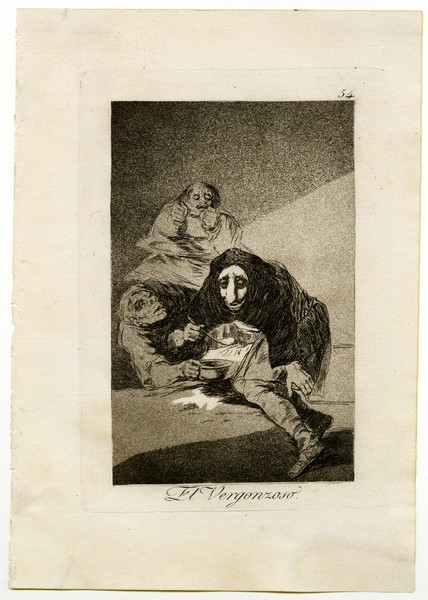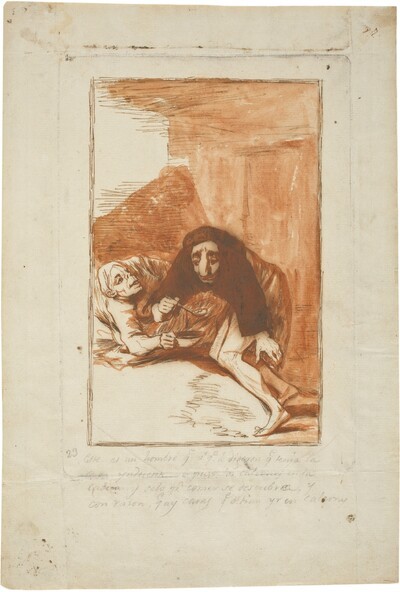- Cronología
- Ca. 1797 - 1799
- Dimensiones
- 217 x 152 mm
- Técnica y soporte
- Etching and aquatint
- Reconocimiento de la autoría de Goya
- Undisputed work
- Ficha: realización/revisión
- 26 Dec 2010 / 29 May 2024
- Inventario
- 225
El Vergonzoso. (at the bottom)
54. (in the upper right-hand corner)
See Francisco de Goya y Lucientes, Painter.
A state proof has survived in which the title appears in manuscript in good calligraphy. A preparatory drawing for this print has also survived.
A man with a huge nose, bushy eyebrows, a big mouth and no chin, wears breeches on his head. He is eating with a spoon from a bowl held by another character with a deformed face. In the background is a man with an alienated face and clenched fists, wearing a nightdress and nightcap.
Goya used aquatint on almost the entire surface of the engraving, while he used etching to create the figures and worked intensely on the clothes of the man eating with a spoon. He has reserved a white area under the plate that could allude to the soup that has fallen. There are no spatial references to indicate where these three figures are located or to provide any information for the interpretation of the scene.
This is a rather complex print for which the surviving manuscripts do not provide very clear guidelines for interpretation. The Prado Museum and Ayala manuscripts give the same explanation: "There are men whose face is the most indecent part of their whole body, and it would be good for those who have the unfortunate and ridiculous ones to put them in their breeches". The manuscript of the National Library tells us the following about this engraving: "Men with big noses are usually also men with big birote and fat gandumbas. As they usually engage in sodomy, the latter is represented with breeches for a cap, revealing his shame through the trap, and in the act of lying on a poor devil and rolling up his skirtsleeves".
This engraving must be related to some works in which Goya has dealt with madness or mental derangement, such as Barnyard of Madmen. The absorbed posture of the figure in the background leads us to think that it could be a scene taking place inside an insane asylum. The Aragonese painter questioned on several occasions what was going on in the abysses of the human mind, the irrational and the uncontrollable, subjects that had been dealt with by artists in an exceptional manner up to that time.
The plate is preserved in the National Chalcography (no. 225).
-
Goya. Gemälde Zeichnungen. Graphik. TapisserienKunsthalle BaselBasle1953from January 23th to April 12th 1953cat. 239
-
Goya. La década de Los CaprichosMadrid1992organized by Real Academia de Bellas Artes de San Fernando sponsored by Fundación Central Hispano, Madrid, consultant editor Nigel Glendinnig. From October 26th 1992 to January 10th 1993cat. 146
-
Francisco de GoyaMuseo d'Arte ModernaLugano1996exhibition celebrated from September 22nd to November 17th.cat. 54, p.81
-
Francisco Goya. Sein leben im spiegel der graphik. Fuendetodos 1746-1828 Bordeaux. 1746-1996Galerie KornfeldBern1996from November 21st 1996 to January 1997cat. 60
-
Goya e la tradizione italianaFondazione Magnani RoccaMamiano di Traversetolo (Parma)2006consultant editors Fred Licht and Simona Tosini Pizzetti. From September 9th to December 3th 2006cat. 54, p.159
-
Goya. Opera graficaPinacoteca del Castello di San GiorgioLegnano2006exhibition celebrated from December 16th 2006 to April 1st 2007p.38
-
Goya et la modernitéPinacothèque de ParisParís2013from October 11st 2013 to March 16th 2014cat. 161
-
Madrid2017
-
Goya engravings and lithographs, vol. I y II.OxfordBruno Cassirer1964p.129, cat. 89
-
Vie et ouvre de Francisco de GoyaParísOffice du livre1970p.182, cat. 559
-
Goya, la década de los caprichos: dibujos y aguafuertesMadridReal Academia de Bellas Artes de San Fernando1992pp.242-245, cat. 145-147
-
Catálogo de las estampas de Goya en la Biblioteca NacionalMadridMinisterio de Educación y Cultura, Biblioteca Nacional1996p.102, cat. 143
-
El libro de los caprichos: dos siglos de interpretaciones (1799-1999). Catálogo de los dibujos, pruebas de estado, láminas de cobre y estampas de la primera ediciónMadridMuseo Nacional del Prado1999pp.286-289
-
ZaragozaGobierno de Aragón y Fundación Bancaria Ibercaja2017p. 244
-
ParísPinacoteca de París2013p. 226
-
Goya. In the Norton Simon MuseumPasadenaNorton Simon Museum2016pp. 42-75

